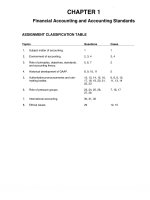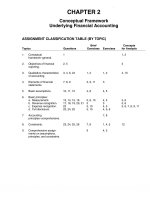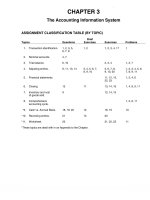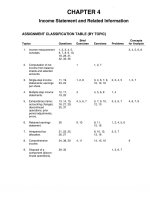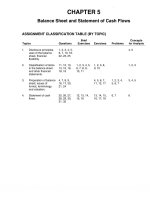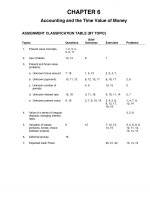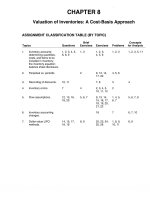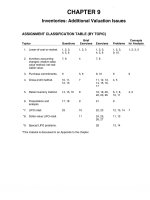Solution manual intermediate accounting 13e kieso ch12
Bạn đang xem bản rút gọn của tài liệu. Xem và tải ngay bản đầy đủ của tài liệu tại đây (361.67 KB, 54 trang )
To download more slides, ebook, solutions and test bank, visit
CHAPTER 12
Intangible Assets
ASSIGNMENT CLASSIFICATION TABLE (BY TOPIC)
Topics
Questions
1.
Intangible assets;
concepts, definitions;
items comprising
intangible assets.
1, 2, 3, 4, 5, 6,
7, 8, 9, 10, 11,
12, 13, 14, 26,
27, 29
2.
Patents; franchise;
organization costs;
trade name.
9, 10, 13, 14,
25, 27, 29
3.
Goodwill.
4.
Brief
Exercises
Exercises
Concepts
Problems for Analysis
1, 2, 3,
5, 6
1, 2, 3, 4
1, 2, 3
1, 2, 3, 4,
7, 12, 13
4, 5, 6, 7,
8, 9, 10,
11, 13
1, 2, 3,
4, 6
1, 2
12, 13, 14, 18
5, 6, 8
6, 12, 13,
15
5, 6
Impairment of
intangibles.
15, 16, 17,
18, 26, 29
7, 8
14, 15
6
5.
Research and
development costs
and similar costs.
19, 20, 21,
22, 23, 24
9, 10, 11, 12
4, 16, 17
1, 2, 3
*6.
Computer software
costs.
30, 31, 32
14
18, 19
4, 5
*This material is covered in an Appendix to the chapter.
Copyright © 2010 John Wiley & Sons, Inc.
Kieso, Intermediate Accounting, 13/e, Solutions Manual
(For Instructor Use Only)
12-1
To download more slides, ebook, solutions and test bank, visit
ASSIGNMENT CLASSIFICATION TABLE (BY LEARNING OBJECTIVE)
Brief
Exercises
Learning Objectives
Exercises
Problems
1.
Describe the characteristics of intangible assets.
2.
Identify the costs to include in the initial valuation
of intangible assets.
1, 2, 3,
4, 5
5, 7, 9,
10, 11
1, 2, 3, 6
3.
Explain the procedure for amortizing intangible
assets.
1, 2, 3, 4,
12, 13
4, 5, 6, 7, 9,
10, 11, 13
1, 2, 3, 6
4.
Describe the types of intangible assets.
1, 2, 3
5.
Explain the conceptual issues related to goodwill.
12, 13
6.
Describe the accounting procedures for recording
goodwill.
5
12, 13, 15
5, 6
7.
Explain the accounting issues related to intangibleasset impairments.
6, 7, 8, 9
14, 15
5, 6
8.
Identify the conceptual issues related to research
and development costs.
9.
Describe the accounting for research and
development and similar costs.
9, 10, 11, 12
Indicate the presentation of intangible assets
and related items.
13
Understand the accounting treatment for computer
software costs.
14
10.
*11.
1, 2, 3
5, 9
6, 8, 16, 17
4
4, 6
18, 19
*This material is covered in an Appendix to the chapter.
12-2
Copyright © 2010 John Wiley & Sons, Inc.
Kieso, Intermediate Accounting, 13/e, Solutions Manual
(For Instructor Use Only)
To download more slides, ebook, solutions and test bank, visit
ASSIGNMENT CHARACTERISTICS TABLE
Item
Description
Level of
Difficulty
Time
(minutes)
E12-1
E12-2
E12-3
E12-4
E12-5
E12-6
E12-7
E12-8
E12-9
E12-10
E12-11
E12-12
E12-13
E12-14
E12-15
E12-16
E12-17
*E12-18
*E12-19
Classification issues—intangibles.
Classification issues—intangibles.
Classification issues—intangible asset.
Intangible amortization.
Correct intangible asset account.
Recording and amortization of intangibles.
Accounting for trade name.
Accounting for organization costs.
Accounting for patents, franchises, and R&D.
Accounting for patents.
Accounting for patents.
Accounting for goodwill.
Accounting for goodwill.
Copyright impairment.
Goodwill impairment.
Accounting for R&D costs.
Accounting for R&D costs.
Accounting for computer software costs.
Accounting for computer software costs.
Moderate
Simple
Moderate
Moderate
Moderate
Simple
Simple
Simple
Moderate
Moderate
Moderate
Moderate
Simple
Simple
Simple
Moderate
Moderate
Moderate
Moderate
15–20
10–15
10–15
15–20
15–20
15–20
10–15
10–15
15–20
20–25
15–20
20–25
10–15
15–20
15–20
15–20
10–15
10–15
15–20
P12-1
P12-2
P12-3
P12-4
P12-5
P12-6
Correct intangible asset account.
Accounting for patents.
Accounting for franchise, patents, and trade name.
Accounting for R&D costs.
Goodwill, impairment.
Comprehensive intangible assets.
Moderate
Moderate
Moderate
Moderate
Complex
Moderate
15–20
20–30
20–30
15–20
25–30
30–35
CA12-1
CA12-2
CA12-3
CA12-4
CA12-5
Accounting for pollution expenditure.
Accounting for pre-opening costs.
Accounting for patents.
Accounting for research and development costs.
Accounting for research and development costs.
Moderate
Moderate
Moderate
Moderate
Moderate
25–30
20–25
25–30
25–30
20–25
Copyright © 2010 John Wiley & Sons, Inc.
Kieso, Intermediate Accounting, 13/e, Solutions Manual
(For Instructor Use Only)
12-3
To download more slides, ebook, solutions and test bank, visit
SOLUTIONS TO CODIFICATION EXERCISES
CE12-1
According to the Master Glossary:
(a) Intangible assets are assets (not including financial assets) that lack physical substance. (The
term intangible assets is used to refer to intangible assets other than goodwill.)
(b) Goodwill is the excess of the cost of an acquired entity over the net of the amounts assigned to
assets acquired and liabilities assumed. The amount recognized as goodwill includes acquired
intangible assets that do not meet the criteria in Topic 805 for recognition as an asset apart from
goodwill.
(c) Research and Development:
Research is planned search or critical investigation aimed at discovery of new knowledge with the
hope that such knowledge will be useful in developing a new product or service (referred to as
product) or a new process or technique (referred to as process) or in bringing about a significant
improvement to an existing product or process.
Development is the translation of research findings or other knowledge into a plan or design for a
new product or process or for a significant improvement to an existing product or process whether
intended for sale or use. It includes the conceptual formulation, design, and testing of product
alternatives, construction of prototypes, and operation of pilot plants.
(d) A development stage entity is an entity devoting substantially all of its efforts to establishing a new
business and for which either of the following conditions exists:
1. Planned principal operations have not commenced.
2. Planned principal operations have commenced, but there has been no significant revenue
therefrom.
CE12-2
See FASB ASC 350-30-35. In the discussions related to “Determining the Useful Life of an Intangible
Asset”
35-1
The accounting for a recognized intangible asset is based on its useful life to the reporting
entity. An intangible asset with a finite useful life shall be amortized; an intangible asset with an
indefinite useful life shall not be amortized.
35-2
The useful life of an intangible asset to an entity is the period over which the asset is expected
to contribute directly or indirectly to the future cash flows of that entity. The useful life is not the
period of time that it would take that entity to internally develop an intangible asset that would
provide similar benefits.
12-4
Copyright © 2010 John Wiley & Sons, Inc.
Kieso, Intermediate Accounting, 13/e, Solutions Manual
(For Instructor Use Only)
To download more slides, ebook, solutions and test bank, visit
CE12-2 (Continued)
35-3
The estimate of the useful life of an intangible asset to an entity shall be based on an analysis of
all pertinent factors, in particular:
•
•
•
•
•
•
35-4
The expected use of the asset by the entity.
The expected useful life of another asset or a group of assets to which the useful life of the
intangible asset may relate.
Any legal, regulatory, or contractual provisions that may limit the useful life. The cash flows
and useful lives of intangible assets that are based on legal rights are constrained by the
duration of those legal rights. Thus, the useful lives of such intangible assets cannot extend
beyond the length of their rights and may be shorter.
Any legal, regulatory, or contractual provisions that enable renewal or extension of the asset’s
legal or contractual life without substantial cost (provided there is evidence to support renewal
or extension and renewal or extension can be accomplished without material modifications
of the existing terms and conditions). Whether the cost of renewal is substantial shall be
determined based on the relationship based on the relationship of the renewal cost to the
fair value of the intangible asset at the time it is acquired.
The effects of obsolescence, demand, competition, and other economic factors (such as the
stability of the industry, known technological advances, legislative action that results in an
uncertain or changing regulatory environment, and expected changes in distribution channels).
The level of maintenance expenditures required to obtain the expected future cash flows from
the asset (for example, a material level of required maintenance in relation to the carrying
amount of the asset may suggest a very limited useful life). As in determining the useful life
of depreciable tangible assets, regular maintenance may be assumed but enhancements
may not.
If no legal, regulatory, contractual, competitive, economic, or other factors limit the useful life of
an intangible asset to the reporting entity, the useful life of the asset shall be considered to be
indefinite. The term indefinite does not mean the same as infinite or indeterminate. The useful
life of an intangible asset is indefinite if that life extends beyond the foreseeable horizon—that
is, there is no foreseeable limit on the period of time over which it is expected to contribute to
the cash flows of the reporting entity. Such intangible assets might be airport route authorities,
certain trademarks, and taxicab medallions.
CE12-3
According the FASB ASC 730-10-50:
50-1
Disclosure shall be made in the financial statements of the total research and development
costs charged to expense in each period for which an income statement is presented.
Copyright © 2010 John Wiley & Sons, Inc.
Kieso, Intermediate Accounting, 13/e, Solutions Manual
(For Instructor Use Only)
12-5
To download more slides, ebook, solutions and test bank, visit
CE12-4
According the FASB ASC 926-720-25,
General
Overall Deals
25-1
An entity may enter into an overall deal arrangement. An entity shall charge the costs of overall
deals that cannot be identified with specific projects to expenses as they are incurred over the
related time period.
> Exploitation Costs
An entity shall account for advertising costs in accordance with the provisions of Subtopic
720-35-25-1;
The costs of advertising shall be expensed either as incurred or the first time the advertising
takes place. The accounting policy selected from these two alternatives shall be applied
consistently to similar kinds of advertising activities. Deferring the costs of advertising until the
advertising takes place assumes that the costs have been incurred for advertising that will
occur. Such costs shall be expensed immediately if such advertising is not expected to occur.
Examples of the first time advertising takes place include the first public showing of a television
commercial for its intended purpose and the first appearance of a magazine advertisement for
its intended purpose.
12-6
Copyright © 2010 John Wiley & Sons, Inc.
Kieso, Intermediate Accounting, 13/e, Solutions Manual
(For Instructor Use Only)
To download more slides, ebook, solutions and test bank, visit
ANSWERS TO QUESTIONS
1. The two main characteristics of intangible assets are:
(a) they lack physical substance.
(b) they are not a financial instrument.
2. If intangibles are acquired for stock, the cost of the intangible is the fair value of the consideration
given or the fair value of the consideration received, whichever is more clearly evident.
3. Limited-life intangibles should be amortized by systematic charges to expense over their useful
life. An intangible asset with an indefinite life is not amortized.
4. When intangibles are created internally, it is often difficult to determine the validity of any future
service potential. To permit deferral of these types of costs would lead to a great deal of subjecttivity because management could argue that almost any expense could be capitalized on the basis
that it will increase future benefits. The cost of purchased intangibles, however, is capitalized
because its cost can be objectively verified and reflects its fair value at the date of acquisition.
5. Companies cannot capitalize self-developed, self-maintained, or self-created goodwill. These expenditures would most likely be reported as selling expenses.
6. Factors to be considered in determining useful life are:
(a) The expected use of the asset by the entity.
(b) The expected useful life of another asset or a group of assets to which the useful life of the
intangible asset may relate.
(c) Any legal, regulatory, or contractual provisions that may limit useful life.
(d) Any legal, regulatory or contractual provisions that enable renewal or extension of the asset’s
legal or contractual life without substantial cost.
(e) The effects of obsolescence, demand, competition, and other economic factors.
(f) The level of maintenance expenditure required to obtain the expected future cash flows from
the asset.
7. The amount of amortization expensed for a limited-life intangible asset should reflect the pattern in
which the asset is consumed or used up, if that pattern can be reliably determined. If the pattern of
production or consumption cannot be determined, the straight-line method of amortization should
be used.
8. This trademark is an indefinite life intangible and, therefore, should not be amortized.
9. The $190,000 should be expensed as research and development expense in 2010. The $91,000 is
expensed as selling and promotion expense in 2010. The $45,000 of costs to legally obtain the
patent should be capitalized and amortized over the useful or legal life of the patent, whichever is
shorter.
10. Patent Amortization Expense ....................................................................
Patents (or Accumulated Patent Amortization)................................
35,000
35,000
Straight-line amortization is used because the pattern of use can not be reliably determined.
11. Artistic-related intangible assets involve ownership rights to plays, pictures, photographs, and
video and audiovisual material. These ownership rights are protected by copyrights. Contract related
intangible assets represent the value of rights that arise from contractual arrangements. Examples
are franchise and licensing agreements, construction permits, broadcast rights, and service or
supply contracts.
Copyright © 2010 John Wiley & Sons, Inc.
Kieso, Intermediate Accounting, 13/e, Solutions Manual
(For Instructor Use Only)
12-7
To download more slides, ebook, solutions and test bank, visit
Questions Chapter 12 (Continued)
12. Varying approaches are used to define goodwill. They are
(a) Goodwill should be measured initially as the excess of the fair value of the acquisition cost
over the fair value of the net assets acquired. This definition is a measurement definition but
does not conceptually define goodwill.
(b) Goodwill is sometimes defined as one or more unidentified intangible assets and identifiable
intangible assets that are not reliably measurable. Examples of elements of goodwill include
new channels of distribution, synergies of combining sales forces, and a superior management team.
(c) Goodwill may also be defined as the intrinsic value that a business has acquired beyond the
mere value of its net assets whether due to the personality of those conducting it, the nature
of its location, its reputation, or any other circumstance incidental to the business and tending
to make it permanent. Another definition is the capitalized value of the excess of estimated
future profits of a business over the rate of return on capital considered normal in the industry.
Negative goodwill develops when the fair value of the assets purchased is higher than the cost.
This situation may develop from a market imperfection. In this case, the seller would have been
better off to sell the assets individually than in total. However, situations do occur (e.g., a forced
liquidation or distressed sale due to the death of the company founder), in which the purchase price
is less than the value of the identifiable net assets.
13. Goodwill is recorded only when it is acquired by purchase. Goodwill acquired in a business
combination is considered to have an indefinite life and therefore should not be amortized, but
should be tested for impairment on at least an annual basis.
14. Many analysts believe that the value of goodwill is so subjective that it should not be given the
same status as other types of assets such as cash, receivables, inventory, etc. The analysts are
simply stating that they believe that presentation of goodwill on the balance sheet does not provide
any useful information to the users of financial statements. Whether this is true or not is a difficult
point to prove, but it should be noted that it appears contradictory to pay for the goodwill and then
immediately write it off, denying that it has any value.
15. Accounting standards require that if events or changes in circumstances indicate that the carrying
amount of such assets may not be recoverable, then the carrying amount of the asset should be
assessed. The assessment or review takes the form of a recoverability test that compares the sum
of the expected future cash flows from the asset (undiscounted) to the carrying amount. If the cash
flows are less than the carrying amount, the asset has been impaired. The impairment loss is
measured as the amount by which the carrying amount exceeds the fair value of the asset. The
fair value of assets is measured by their fair value if an active market for them exists. If no market
price is available, the present value of the expected future net cash flows from the asset may be
used.
16. Under U.S. GAAP, impairment losses on assets held for use may not be restored.
17. Impairment losses are reported as part of income from continuing operations, generally in the
“Other expenses and losses” section. Impairment losses (and recovery of losses for assets to be
disposed of) are similar to other costs that would flow through operations. Thus, gains (recoveries
of losses) on assets to be disposed of should be reported as part of income from continuing
operations.
18. The amount of goodwill impaired is $40,000, computed as follows:
Recorded goodwill .........................................................
$400,000
Implied goodwill..............................................................
360,000
Impaired goodwill ...........................................................
$ 40,000
12-8
Copyright © 2010 John Wiley & Sons, Inc.
Kieso, Intermediate Accounting, 13/e, Solutions Manual
(For Instructor Use Only)
To download more slides, ebook, solutions and test bank, visit
Questions Chapter 12 (Continued)
19. Research and development costs are incurred to develop new products or processes, to improve
present products, or to discover new knowledge. R&D expenditures present problems of
(1) identifying the costs associated with particular activities, projects, or achievements, and
(2) determining the magnitude of the future benefits and the length of time over which such
benefits may be realized. R&D activities may incur costs classified as follows:
(a) materials, equipment, and facilities,
(b) personnel,
(c) purchased intangibles,
(d) contract services, and
(e) indirect costs.
20. (a) Personnel (labor) type costs incurred in R&D activities should be expensed as incurred.
(b) Materials and equipment costs should be expensed immediately unless the items have
alternative future uses. If the items have alternative future uses, the materials should be
recorded as inventories and allocated as consumed and the equipment should be capitalized
and depreciated as used.
(c) Indirect costs of R&D activities should be reasonably allocated to R&D (except for general and
administrative costs, which must be clearly related to be included) and expensed.
21. See Illustration 12-14.
1.
2.
3.
4.
5.
6.
7.
8.
9.
Type of Expenditure
Construction of long-range research facility
for use in current and future projects (threestory, 400,000-square-foot building).
Acquisition of R&D equipment for use on
current project only.
Acquisition of machinery for use on current
and future R&D projects.
Purchase of materials for use on current
and future R&D projects.
Salaries of research staff designing new
laser bone scanner.
Research costs incurred under contract with
New Horizon, Inc., and billable monthly.
Material, labor, and overhead costs of
prototype laser scanner.
Costs of testing prototype and design
modifications.
Legal fees to obtain patent on new laser
scanner.
10.
Executive salaries.
11.
Cost of marketing research to promote new
laser scanner.
Engineering costs incurred to advance the
laser scanner to full production stage.
Costs of successfully defending patent on
laser scanner.
Commissions to sales staff marketing new
laser scanner.
12.
13.
14.
Accounting Treatment
Capitalize and depreciate as R&D expense
Expense immediately as R&D.
Capitalize and depreciate as R&D expense.
Inventory and allocate to R&D projects;
expense as consumed.
Expense immediately as R&D.
Record as a receivable (reimbursable
expenses).
Expense immediately as R&D.
Expense immediately as R&D.
Capitalize as patent and amortize to
overhead as part of cost of goods
manufactured.
Expense as operating expense (general
and administrative).
Expense as operating expense (selling).
Expense immediately as R&D.
Capitalize as patent and amortize to overhead as part of cost of goods manufactured.
Expense as operating expense (selling).
(a) Expense as R&D.
(b) Expense as R&D.
(c) Capitalize as patent and/or license and amortize.
Copyright © 2010 John Wiley & Sons, Inc.
Kieso, Intermediate Accounting, 13/e, Solutions Manual
(For Instructor Use Only)
12-9
To download more slides, ebook, solutions and test bank, visit
Questions Chapter 12 (Continued)
22. Each of these items should be charged to current operations. Advertising costs have some minor
exceptions to this general rule. However, the specific accounting is beyond the scope of this
textbook.
23. $585,000 ($400,000 + $60,000 + $125,000).
24. These costs are referred to as start-up costs, or more specifically organizational costs in this case.
The accounting for start up costs is straightforward—expense these costs as incurred. The
profession recognizes that these costs are incurred with the expectation that future revenues will
occur or increased efficiencies will result. However, to determine the amount and timing of future
benefits is so difficult that a conservative approach—expensing these costs as incurred—is
required.
25. The total life, per revised facts, is 40 years (10 + 30). There are 30 (40 – 10) remaining years for
amortization purposes. Original amortization:
$540,000
= $18,000 per year; $18,000 X 10 years
30
expired = $180,000 accumulated amortization.
$540,000
–180,000
$360,000
original cost
accumulated amortization
remaining cost to amortize
$360,000 ÷ 30 years = $12,000 amortization for 2010 and years thereafter.
26. iGAAP related to intangible assets is presented in IAS 38, “Intangible Assets. iGAAP related to
impairments is found in IAS 36, “Impairment of Assets”.
27. Similarities include (1) in U.S. GAAP and iGAAP, the costs associated with research and
development are segregated into the two components; (2) iGAAP and U.S. GAAP are similar for
intangibles acquired in a business combination. That is, an intangible asset is recognized
separately from goodwill if it represents contractual or legal rights or is capable of being separated
or divided and sold, transferred, licensed, rented or exchanged; (3) Under both GAAPs, limited life
intangibles are subject to amortization, but goodwill and indefinite life intangibles are not
amortized; rather they are assessed for impairment on an annual basis; (4) iGAAP and U.S. GAAP
are similar in the accounting for impairments of assets held for disposal.
Notable differences are: (1) while costs in the research phase are always expensed under both
iGAAP and U.S. GAAP, under iGAAP costs in the development phase are capitalized once
technological feasibility is achieved; (2) iGAAP permits some capitalization of internally generated
intangible assets (e.g., brand value), if it is probable there will be a future benefit and the amount
can be reliably measured. U.S. GAAP requires expensing of all costs associated with internally
generated intangibles; (3) iGAAP requires an impairment test at each reporting date for long-lived
assets and intangibles and records an impairment if the asset’s carrying amount exceeds its
recoverable amount; the recoverable amount is the higher of the asset’s fair value less costs to
sell and its value in use. Value in use is the future cash flows to be derived from the particular
asset, discounted to present value. Under U.S. GAAP, impairment loss is measured as the excess
of the carrying amount over the asset’s fair value; (4) iGAAP allows reversal of impairment losses
when there has been a change in economic conditions or in the expected use of the asset. Under
U.S. GAAP, impairment losses cannot be reversed for assets to be held and used; the impairment
loss results in a new cost basis for the asset; (5) under iGAAP, acquired in-process research and
development (IPR&D) is recognized as a separate intangible asset if it meets the definition of an
intangible asset and its fair value can be measured reliably. U.S. requires acquired IPR&D to be
written off.
12-10
Copyright © 2010 John Wiley & Sons, Inc.
Kieso, Intermediate Accounting, 13/e, Solutions Manual
(For Instructor Use Only)
To download more slides, ebook, solutions and test bank, visit
Questions Chapter 12 (Continued)
28. As shown in the analysis below, under iGAAP, Sophia’s ROA is overstated compared to a U.S.
GAAP company.
Income
Assets
ROA (Income ÷ Assets)
iGAAP
€1,125
12,500
9%
U.S. GAAP
€920*
12,295**
7.5%
*( € 1,125 + € 120 – € 325)
**( € 12,500 + € 120 – € 325)
29. The IASB and FASB have identified a project relating to the accounting for research and development that could possibly converge iGAAP and U.S. GAAP on the issue of in-process R&D. One
possibility is to amend U.S. GAAP to allow capitalization of in-process R&D similar to the provisions
in iGAAP. A second project, in a very preliminary stage, would consider expanded recognition of
internally generated intangible assets. As indicated, iGAAP permits more recognition of intangibles
compared to U.S. GAAP. Thus, it will be challenging to develop converged standards for intangible
assets, given the long-standing prohibition on capitalizing intangible assets and research and
development in U.S. GAAP. Learn more about the timeline for the intangible asset project at the
IASB web-site: />*30. The profession’s position is that costs incurred internally in creating a computer software product
to be sold should be charged to expense when incurred as research and development until technological feasibility has been established for the product. Technological feasibility is established upon
completion of a detailed program design or, in its absence, completion of a working model.
Thereafter, all software costs should be capitalized and subsequently reported at the lower of
unamortized cost or net realizable value. Capitalized costs are amortized based on current and
future revenue for each product with an annual minimum equal to straight-line amortization over
the remaining estimated economic life of the product.
*31. Under the percent of revenue approach, $900,000
$2,000,000
$4,500,000
X
000
$2,000,000 + $8,000,0
would
be reported; under the straight-line approach, $1,125,000 would be reported. Because the straightline approach is higher, $1,125,000 should be reported as R&D expense for this product.
*32. Expensing the development cost in the current year is appropriate when the costs are classified as
research and development costs and the computer software is to be sold, leased, or marketed to
third parties.
Capitalizing the development cost of the software package over its estimated useful life is
appropriate if the costs are subsequent to achieving technological feasibility and future benefits
are reasonably certain.
Stakeholders (users of financial statements or parties affected by financial statements) may be
harmed whenever expenses and revenues are mismatched. Inappropriate recognition of development costs can harm all parties involved due to any understatement and overstatement of income.
Copyright © 2010 John Wiley & Sons, Inc.
Kieso, Intermediate Accounting, 13/e, Solutions Manual
(For Instructor Use Only)
12-11
To download more slides, ebook, solutions and test bank, visit
SOLUTIONS TO BRIEF EXERCISES
BRIEF EXERCISE 12-1
Patents....................................................................................
Cash..............................................................................
54,000
Patent Amortization Expense .........................................
Patents ($54,000 X 1/10 = $5,400)........................
5,400
54,000
5,400
BRIEF EXERCISE 12-2
Patents....................................................................................
Cash..............................................................................
24,000
Patent Amortization Expense .........................................
Patents [($43,200 + $24,000) X 1/8 = $8,400]........
8,400
24,000
8,400
BRIEF EXERCISE 12-3
Trade Name ...........................................................................
Cash..............................................................................
68,000
Trade Name Amortization Expense ..............................
Trade Name ($68,000 X 1/8 = $8,500) .................
8,500
68,000
8,500
BRIEF EXERCISE 12-4
Franchise ...................................................................................
Cash..................................................................................
120,000
Franchise Amortization Expense.......................................
Franchise ($120,000 X 1/8 X 9/12 = $11,250)........
11,250
12-12
Copyright © 2010 John Wiley & Sons, Inc.
120,000
Kieso, Intermediate Accounting, 13/e, Solutions Manual
11,250
(For Instructor Use Only)
To download more slides, ebook, solutions and test bank, visit
BRIEF EXERCISE 12-5
Purchase price..........................................................................
Fair value of assets.................................................................
Fair value of liabilities ............................................................
Fair value of net assets..........................................................
Value assigned to goodwill ..................................................
$700,000
$800,000
200,000
600,000
$100,000
BRIEF EXERCISE 12-6
Loss on Impairment ................................................................
Patents ($300,000 – $110,000)...................................
190,000
190,000
Note: An impairment has occurred because expected net future cash flows
($210,000) are less than the carrying amount ($300,000). The loss is measured
as the difference between the carrying amount and fair value ($110,000).
BRIEF EXERCISE 12-7
Because the fair value of the division exceeds the carrying amount of the
assets, goodwill is not considered to be impaired. No entry is necessary.
BRIEF EXERCISE 12-8
Loss on Impairment ($400,000 – $350,000).................
Goodwill .......................................................................
50,000
50,000
The fair value of the reporting unit ($750,000) is less than the carrying value
($800,000)—an impairment has occurred. The loss is the difference between
the recorded goodwill and the implied goodwill.
Copyright © 2010 John Wiley & Sons, Inc.
Kieso, Intermediate Accounting, 13/e, Solutions Manual
(For Instructor Use Only)
12-13
To download more slides, ebook, solutions and test bank, visit
BRIEF EXERCISE 12-9
Organization Cost Expense.............................................
Cash..............................................................................
60,000
60,000
BRIEF EXERCISE 12-10
Research and Development Expense ..........................
Cash..............................................................................
430,000
430,000
BRIEF EXERCISE 12-11
(a)
(b)
(c)
(d)
Capitalize
Expense
Expense
Expense
BRIEF EXERCISE 12-12
Carrying
Amount
Patent (1/1/10)
$288,000
Legal costs (12/1/10)
85,000
$373,000
Life in
Months
96
85
Amortization
Per Month
$3,000
$1,000
Carrying amount................................................................
Less: Amortization of patent (12 X $3,000) .............
Legal costs amortization (1 X $1,000)...........
Carrying amount 12/31/10 ..............................................
12-14
Copyright © 2010 John Wiley & Sons, Inc.
Months
Amortization
12
1
$373,000
(36,000)
(1,000)
$336,000
Kieso, Intermediate Accounting, 13/e, Solutions Manual
(For Instructor Use Only)
To download more slides, ebook, solutions and test bank, visit
BRIEF EXERCISE 12-13
Copyright No. 1 for $9,900 should be expensed and therefore not reported
on the balance sheet.
Copyright No. 2 for $24,000 should be capitalized. Because the useful life is
indefinite, copyright No. 2 should be tested at least annually for impairment
using a fair value test. It would be reflected on the December 31, 2010
balance sheet at its cost of $24,000.
*BRIEF EXERCISE 12-14
Percent of revenue approach
$800,000 X
$420,000
$1,400,000*
= $240,000
*($420,000 + $980,000)
Straight-line approach
$800,000 X 1/4 = $200,000
Amortization is $240,000; percentage of revenue is greater.
Copyright © 2010 John Wiley & Sons, Inc.
Kieso, Intermediate Accounting, 13/e, Solutions Manual
(For Instructor Use Only)
12-15
To download more slides, ebook, solutions and test bank, visit
SOLUTIONS TO EXERCISES
EXERCISE 12-1 (15–20 minutes)
(a)
(b)
10, 13, 15, 16, 17, 19, 23
1.
2.
3.
4.
5.
6.
7.
8.
9.
11.
12.
14.
18.
20.
21.
22.
Long-term investments in the balance sheet.
Property, plant, and equipment in the balance sheet.
Research and development expense in the income statement.
Current asset (prepaid rent) in the balance sheet.
Property, plant, and equipment in the balance sheet.
Research and development expense in the income statement.
Charge as expense in the income statement.
Operating losses in the income statement.
Charge as expense in the income statement.
Not recorded; any costs related to creating goodwill incurred
internally must be expensed.
Research and development expense in the income statement.
Research and development expense in the income statement.
Research and development expense in the income statement.
Research and development expense in the income statement.
Long-term investments, or other assets, in the balance sheet.
Expensed in the income statement.
EXERCISE 12-2 (10–15 minutes)
The following items would be classified as an intangible asset:
Cable television franchises
Film contract rights
Music copyrights
Customer lists
Goodwill
Covenants not to compete
Internet domain name
Brand names
Cash, accounts receivable, notes receivable, and prepaid expenses would
be classified as current assets.
Property, plant, and equipment, and land would be classified as non-current
assets in the property, plant, and equipment section.
12-16
Copyright © 2010 John Wiley & Sons, Inc.
Kieso, Intermediate Accounting, 13/e, Solutions Manual
(For Instructor Use Only)
To download more slides, ebook, solutions and test bank, visit
EXERCISE 12-2 (Continued)
Investments in affiliated companies would be classified as part of the
investments section of the balance sheet.
Research and development costs would be classified as an operating
expense.
Discount on notes payable is shown as a deduction from the related notes
payable on the balance sheet.
Organization costs are start-up costs and should be expensed as incurred.
EXERCISE 12-3 (10–15 minutes)
(a)
(b)
Trademarks.......................................................................................
Excess of cost over fair value of net identifiable
assets of acquired subsidiary (goodwill)............................
Total intangible assets..................................................................
$20,000
75,000
$95,000
Organization costs, $24,000, should be expensed.
Discount on bonds payable, $35,000, should be reported as a contra
account to bonds payable in the long-term liabilities section.
Deposits with advertising agency for ads to promote goodwill of
company, $10,000, should be reported either as an expense or as
prepaid advertising in the current assets section. Advertising costs in
general are expensed when incurred or when first used.
Cost of equipment acquired for research and development projects,
$90,000, should be reported with property, plant, and equipment,
because the equipment has an alternative use.
Costs of developing a secret formula for a product that is expected to
be marketed for at least 20 years, $70,000, should be classified as
research and development expense on the income statement.
Copyright © 2010 John Wiley & Sons, Inc.
Kieso, Intermediate Accounting, 13/e, Solutions Manual
(For Instructor Use Only)
12-17
To download more slides, ebook, solutions and test bank, visit
EXERCISE 12-4 (15–20 minutes)
1.
Palmiero should report the patent at $900,000 (net of $600,000
accumulated amortization) on the balance sheet. The computation of
accumulated amortization is as follows.
Amortization for 2008 and 2009 ($1,500,000/10) X 2 ..........
2010 amortization: ($1,500,000 – $300,000) ÷ (6 – 2) .........
Accumulated amortization, 12/31/10.......................................
$300,000
300,000
$600,000
2.
Palmiero should amortize the franchise over its estimated useful life.
Because it is uncertain that Palmiero will be able to retain the franchise
at the end of 2018, it should be amortized over 10 years. The amount of
amortization on the franchise for the year ended December 31, 2010, is
$35,000: ($350,000/10).
3.
These costs should be expensed as incurred. Therefore $275,000 of
organization expense were reported in income for 2008.
4.
Because the license can be easily renewed (at nominal cost), it has an
indefinite life. Thus, no amortization will be recorded. The license will
be tested for impairment in future periods.
EXERCISE 12-5 (15–20 minutes)
Research and Development Expense .................................... 940,000
Patents.............................................................................................. 75,000
Rent Expense [(5 ÷ 7) X $91,000] ............................................. 65,000
Prepaid Rent [(2 ÷ 7) X $91,000] ............................................... 26,000
Advertising Expense.................................................................... 207,000
Income Summary (or a loss account) .................................... 141,000
Discount on Bonds Payable ...................................................... 82,950*
Interest Expense............................................................................
1,050
Paid in Capital in Excess of Par on Common Stock ........
250,000
Intangible Assets ..................................................................
1,288,000
*84,000 ÷ 240 months = $350; $350 X 3 = $1,050; $84,000 – $1,050 = $82,950
Patent Amortization Expense [($75,000 ÷ 12) X 1/2]..........
Patents (or Accumulated Amortization) .....................
12-18
Copyright © 2010 John Wiley & Sons, Inc.
3,125
Kieso, Intermediate Accounting, 13/e, Solutions Manual
3,125
(For Instructor Use Only)
To download more slides, ebook, solutions and test bank, visit
EXERCISE 12-6 (15–20 minutes)
Patents ................................................................................
Goodwill..............................................................................
Franchise............................................................................
Copyright............................................................................
Research and Development Expense.......................
Intangible Assets ..................................................
380,000
360,000
450,000
156,000
215,000
Amortization Expense....................................................
Patents ($380,000/8) .............................................
Franchise ($450,000/10 X 6/12) .........................
Copyright ($156,000/5 X 5/12) ...........................
83,000
1,561,000
47,500
22,500
13,000
Balance of Intangible Assets as of December 31, 2010
Patents
= $380,000 – $47,500 = $332,500
Goodwill
= $360,000 (no amortization)
Franchise = $450,000 – $22,500 = $427,500
Copyright = $156,000 – $13,000 = $143,000
EXERCISE 12-7 (10–15 minutes)
(a)
2009 amortization: $18,000 ÷ 10 = $1,800.
12/31/09 book value: $18,000 – $1,800 = $16,200.
2010 amortization: ($16,200 + $7,800) ÷ 9 = $2,667.
12/31/10 book value: ($16,200 + $7,800 – $2,667) = $21,333.
(b)
2010 amortization: ($16,200 + $7,800) ÷ 4 = $6,000.
12/31/10 book value: $16,200 + $7,800 – $6,000 = $18,000.
(c)
Carrying amount ($21,333) > future cash flows ($17,000); thus the
trade name fails the recoverability test. The new carrying value is
$16,000—the trade name’s fair value.
2011 amortization (after recording impairment loss):
$16,000 ÷ 8 = $2,000.
12/31/11 book value: $16,000 – $2,000 = $14,000.
Copyright © 2010 John Wiley & Sons, Inc.
Kieso, Intermediate Accounting, 13/e, Solutions Manual
(For Instructor Use Only)
12-19
To download more slides, ebook, solutions and test bank, visit
EXERCISE 12-8 (10–15 minutes)
(a)
Attorney’s fees in connection with organization
of the company............................................................................
Costs of meetings of incorporators to discuss
organizational activities ...........................................................
State filing fees to incorporate ..................................................
Total organization costs ..............................................................
$17,000
7,000
1,000
$25,000
Drafting and design equipment, $10,000, should be classified as part of fixed
assets, rather than as organization costs.
(b)
Organization Cost Expense.........................................
Cash (Payables) ....................................................
25,000
25,000
EXERCISE 12-9 (15–20 minutes)
(a)
DEVON HARRIS COMPANY
Intangibles Section of Balance Sheet
December 31, 2010
Patent from Bradtke Company, net of accumulated
amortization of $700,000 (Schedule 1) ..........................................
Franchise from Greene Company, net of accumulated
amortization of $58,000 (Schedule 2).............................................
Total intangibles.......................................................................................
Schedule 1 Computation of Patent from Bradtke Company
Cost of patent at date of purchase.....................................................
Amortization of patent for 2009 ($2,500,000 ÷ 10 years).............
$1,800,000
522,000
$2,322,000
Amortization of patent for 2010 ($2,250,000 ÷ 5 years) ...............
Patent balance...........................................................................................
$2,500,000
(250,000)
2,250,000
(450,000)
$1,800,000
Schedule 2 Computation of Franchise from Greene Company
Cost of franchise at date of purchase...............................................
Amortization of franchise for 2010 ($580,000 ÷ 10) ......................
Franchise balance....................................................................................
$ 580,000
(58,000)
$ 522,000
12-20
Copyright © 2010 John Wiley & Sons, Inc.
Kieso, Intermediate Accounting, 13/e, Solutions Manual
(For Instructor Use Only)
To download more slides, ebook, solutions and test bank, visit
EXERCISE 12-9 (Continued)
(b)
DEVON HARRIS COMPANY
Income Statement Effect
For the Year Ended December 31, 2010
Patent from Bradtke Company:
Amortization of patent for 2010
($2,250,000 ÷ 5 years) .........................................
Franchise from Greene Company:
Amortization of franchise for 2010
($580,000 ÷ 10) ......................................................
Payment to Greene Company
($2,500,000 X 5%) .................................................
Research and development costs..............................
Total charged against income.............................
$ 450,000
$ 58,000
125,000
183,000
433,000
$1,066,000
EXERCISE 12-10 (15–20 minutes)
(a)
2007
2008
Research and Development Expense ......
Cash ..........................................................
170,000
Patents ................................................................
Cash ..........................................................
24,000
Patent Amortization Expense......................
Patents [($24,000 ÷ 10) X 3/12] .........
600
Patent Amortization Expense......................
Patents ($24,000 ÷ 10) .........................
2,400
Copyright © 2010 John Wiley & Sons, Inc.
Kieso, Intermediate Accounting, 13/e, Solutions Manual
170,000
24,000
600
2,400
(For Instructor Use Only)
12-21
To download more slides, ebook, solutions and test bank, visit
EXERCISE 12-10 (Continued)
(b)
2009
2010
(c)
Patents ........................................................................
Cash...................................................................
12,400
Patent Amortization Expense ..............................
Patents ($1,000 + $1,575)............................
[Jan. 1–June 1: ($24,000 ÷ 10) X
5/12 = $1,000
June 1–Dec. 31: ($24,000 – $600 –
$2,400 – $1,000 + $12,400) = $32,400;
($32,400 ÷ 12) X 7/12 = $1,575]
2,575
Patent Amortization Expense ..............................
Patents ($32,400 ÷ 12)..................................
2,700
2011 and 2012
Patent Amortization Expense ..............................
Patents ($28,125 ÷ 2)....................................
($32,400 – $1,575 – $2,700) = $28,125
12,400
2,575
2,700
14,063
14,063
EXERCISE 12-11
(a)
Patent A
Life in years.........................................................................
Life in months (12 X 17) ..................................................
Amortization per month ($40,800 ÷ 204)....................
Number of months amortized to date
Year
Month
2006
2007
2008
2009
17
204
$200
10
12
12
12
46
Book value 12/31/09 $31,600: ($40,800 – [46 X $200])
12-22
Copyright © 2010 John Wiley & Sons, Inc.
Kieso, Intermediate Accounting, 13/e, Solutions Manual
(For Instructor Use Only)
To download more slides, ebook, solutions and test bank, visit
EXERCISE 12-11 (Continued)
Patent B
Life in years ......................................................................
Life in months (12 X 10)................................................
Amortization per month ($15,000 ÷ 120) .................
Number of months amortized to date
Year
Month
2007
2008
2009
10
120
$125
6
12
12
30
Book value 12/31/09 $11,250: ($15,000 – [$125 X 30])
Patent C
Life in years ......................................................................
Life in months (12 X 4) ..................................................
Amortization per month ($14,400 ÷ 48) ...................
Number of months amortized to date
Year
Month
2008
2009
4
48
$300
4
12
16
Book value 12/31/09 $9,600: ($14,400 – [$300 X 16])
At December 31, 2009
Patent A...................................................................
Patent B...................................................................
Patent C...................................................................
Total ....................................................................................
Copyright © 2010 John Wiley & Sons, Inc.
Kieso, Intermediate Accounting, 13/e, Solutions Manual
$31,600
11,250
9,600
$52,450
(For Instructor Use Only)
12-23
To download more slides, ebook, solutions and test bank, visit
EXERCISE 12-11 (Continued)
(b)
Analysis of 2010 transactions
1.
The $245,700 incurred for research and development should be
expensed.
2.
The book value of Patent B is $11,250 and its estimated future
cash flows are $6,000: (3 X $2,000); therefore Patent B is impaired.
The impairment loss is imputed as follows:
Book value.................................................................
$11,250
Less: Present value of future
cash flows ($2,000 X 2.57710) ...............
Loss recognized ......................................................
5,154
$ 6,096
Patent B carrying amount (12/31/10) $5,154
At December 31, 2010
Patent A
$29,200 ($31,600 – [12 X $200])
Patent B
5,154 (Present value of future cash flows)
Patent C
6,000 ($9,600 – [12 X $300])
Patent D
27,000 ($28,500 – $1,500*)
Total
$67,354
*Patent D amortization
Life in years
Life in months
Amortization per month ($28,500 ÷ 114)
$250 X 6 = $1,500
12-24
Copyright © 2010 John Wiley & Sons, Inc.
9 1/2
114
$250
Kieso, Intermediate Accounting, 13/e, Solutions Manual
(For Instructor Use Only)
To download more slides, ebook, solutions and test bank, visit
EXERCISE 12-12 (20–25 minutes)
Net assets of Terrell as reported ........................................
Adjustments to fair value
Increase in land value..................................................
Decrease in equipment value....................................
Net assets of Terrell at fair value........................................
Selling price...............................................................................
Amount of goodwill to be recorded...................................
$225,000
50,000
(5,000)
45,000
270,000
380,000
$110,000
The journal entry to record this transaction is as follows:
Cash .............................................................................................
Land .............................................................................................
Building.......................................................................................
Equipment..................................................................................
Copyright....................................................................................
Goodwill......................................................................................
Accounts Payable.........................................................
Long-term Notes Payable...........................................
Cash ..................................................................................
100,000
120,000
200,000
170,000
30,000
110,000
50,000
300,000
380,000
EXERCISE 12-13 (10–15 minutes)
(a)
Cash ..................................................................................
Receivables ....................................................................
Inventory..........................................................................
Land ..................................................................................
Buildings .........................................................................
Equipment.......................................................................
Trademarks.....................................................................
Goodwill...........................................................................
Accounts Payable..............................................
Notes Payable .....................................................
Cash .......................................................................
50,000
90,000
125,000
80,000
75,000
70,000
15,000
95,000*
200,000
150,000
250,000
*$400,000 – [$235,000 + $40,000 + $25,000 + $5,000]
Note that the building and equipment would be recorded at the 7/1/10
cost to Brandon; accumulated depreciation accounts would not be
recorded.
Copyright © 2010 John Wiley & Sons, Inc.
Kieso, Intermediate Accounting, 13/e, Solutions Manual
(For Instructor Use Only)
12-25

